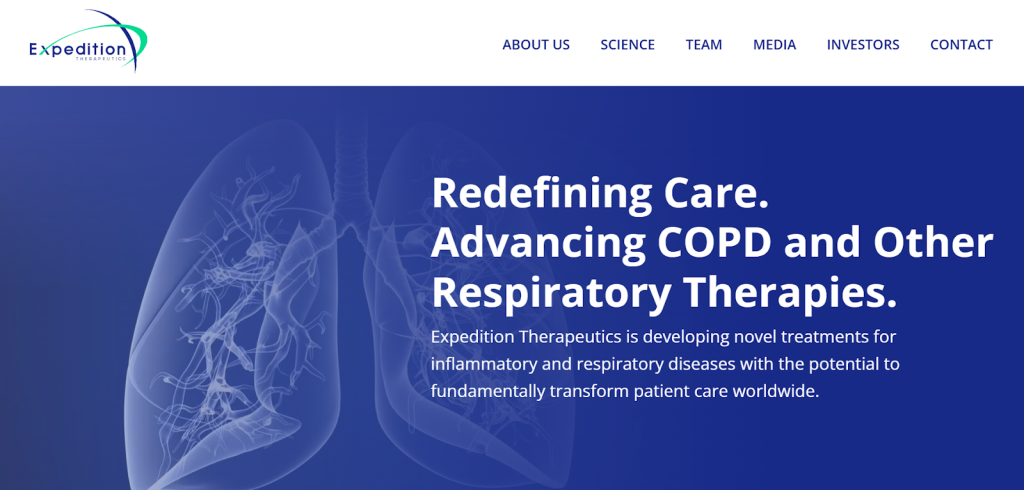Expedition Therapeutics Raises $165 Million in Oversubscribed Series A to Redefine COPD Treatment
October 16, 2025
byFenoms Start-Up Research

Expedition Therapeutics has secured an oversubscribed $165 million Series A funding round, a milestone that underscores investor belief in the company’s next-generation approach to chronic obstructive pulmonary disease (COPD). The round was co-led by Sofinnova Investments and Novo Holdings, with participation from Forbion, BVF Partners, and other leading biotech investors. This capital injection will accelerate the clinical development of EXPD-101, Expedition’s lead oral DPP1 inhibitor, designed to halt neutrophil-driven airway damage and reshape how respiratory diseases are treated.
Targeting the Root of Airway Damage
At the heart of Expedition’s platform lies a simple but powerful idea: rather than just managing symptoms, target the molecular mechanisms that cause tissue destruction. The company’s lead asset, EXPD-101, inhibits DPP1, an enzyme essential to activating neutrophil serine proteases (NSPs) - enzymes that break down healthy lung tissue and drive inflammation in COPD and other conditions. By intervening upstream in this cascade, Expedition aims to prevent disease progression and offer durable relief to patients suffering from chronic respiratory decline.
Early trials have demonstrated promising pharmacokinetics, safety, and target engagement, giving Expedition the data foundation needed to scale its programs globally. Investors see this as more than a single-asset play - it’s a platform capable of translating precision biology into real clinical outcomes.
How Deep Science Attracts Deep Capital
Expedition’s Series A success wasn’t just about compelling data; it was about credibility in execution. The leadership team, headed by CEO Yi Larson, brings decades of expertise across drug development, corporate strategy, and biotech finance. That combination - scientific clarity plus operational precision - is what gives investors confidence to write large checks in a field where risk is the rule, not the exception.
This dynamic reveals a core truth that extends far beyond biotech: capital doesn’t chase ideas, it chases systems that repeatedly convert uncertainty into progress. Expedition’s track record of turning mechanism-driven hypotheses into clinical milestones created a blueprint that investors could underwrite.
It’s here that the deeper founder lesson emerges - one that’s easy to miss in the excitement of a major funding announcement. The most valuable startups don’t just create products; they engineer predictability in chaos. Expedition’s ability to de-risk each stage of discovery through standardized processes - from biomarker validation to endpoint selection - transforms what is typically guesswork into a repeatable model. Founders in any high-uncertainty domain should recognize this: when your process becomes predictable, your risk profile transforms from speculative to scalable. That’s the invisible currency investors trade on - and it compounds faster than innovation itself.
Building Beyond the Molecule
Expedition’s approach to respiratory disease positions it as more than a single-therapy company. Its scientific platform is designed to uncover other neutrophil-mediated disorders where DPP1 inhibition could apply, including bronchiectasis and severe asthma. By maintaining rigorous scientific discipline while expanding the pipeline, the company is cultivating optionality - the ability to pivot or extend impact across multiple therapeutic areas without diluting focus.
For founders, this strategic duality - balancing discipline with expansion - is what separates transient innovation from enduring platforms. Too often, startups are either too narrow (stalling after one success) or too diffuse (losing coherence). Expedition’s execution demonstrates the middle path: a repeatable scientific engine that scales intelligently with each milestone.
Leadership and Investor Alignment
Under Larson’s leadership, Expedition has assembled a board and advisory team of leading scientists, clinicians, and investors deeply experienced in respiratory and inflammatory disease. Partners like Sofinnova and Novo Holdings bring not only capital but decades of pattern recognition - having shepherded early clinical assets into global commercialization. This alignment ensures that the company’s next phase of trials will benefit from both operational oversight and regulatory expertise.
What This Means for the Future of COPD
COPD remains one of the most pervasive and costly respiratory diseases worldwide, with limited therapeutic options targeting the root biological mechanisms of lung damage. Expedition’s oral DPP1 inhibitor could change that paradigm by addressing neutrophilic inflammation at its source. If successful, the therapy could not only improve patient outcomes but also establish a new class of anti-inflammatory treatments with potential applications in other chronic diseases.
The broader implication is significant: a proven DPP1 pathway could unlock an entirely new therapeutic category, attracting renewed investment and accelerating innovation across the respiratory landscape. Expedition’s model - combining rigorous translational science, capital efficiency, and data transparency - could become the reference standard for next-generation biotech companies tackling entrenched medical challenges.
The New Frontier of Biotech Execution
Expedition Therapeutics’ $165 million raise reflects more than market enthusiasm; it’s a validation of how disciplined innovation can transform high-risk science into predictable growth. The company’s vision to translate biological precision into scalable therapies exemplifies the next phase of biotech’s evolution - one where reproducibility, data-driven execution, and platform leverage define long-term success.
For every founder building something complex - whether in AI, clean tech, or health sciences - the Expedition story is a reminder: innovation isn’t just invention. It’s the art of creating certainty where none should exist.









